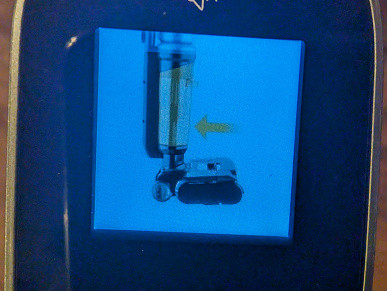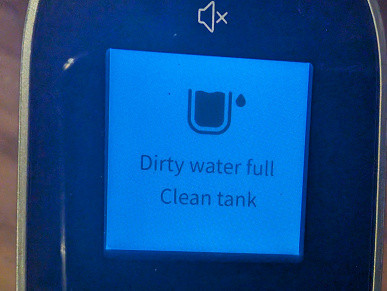The 3-in-1 concept—handheld, sweeping, and mopping modes—is not yet widely accepted among upright vacuum cleaners. But this is convenient: instead of several devices, you can purchase, store and maintain only one.
All three of these features come together in the Jimmy HW10 Pro, and needless to say, we immediately started testing it.
Characteristics
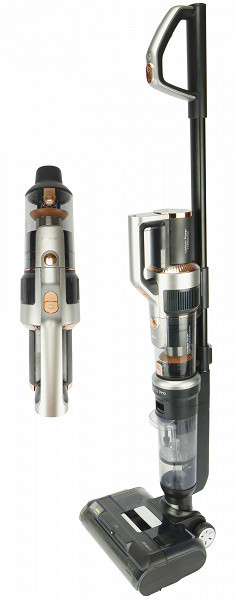
| Manufacturer | Jimmy |
|---|---|
| Model | HW10 Pro |
| Type | 3-in-1 vertical vacuum cleaner with wet cleaning function |
| Country of Origin | China |
| Guarantee | 1 year |
| Life time * | 5 years |
| Type of cleaning | dry, wet |
| Power | 400 W |
| Suction power | 75 W |
| Battery life | 60 minutes |
| Battery | Li-Ion, 3800 mAh |
| Charging time | 4 hours |
| Dust container volume | 0.5 l |
| Cleaning modes | 2 |
| Display | OLCD |
| Self-cleaning mode | There is |
| Voice prompts | There is |
| Noise level | 80 dB |
| Weight | 5 kg |
| Dimensions (W×H×D) | 324×730×426 mm |
| Network cable length | 1.5 m |
* Contrary to popular belief, this is not the time limit after which the device will necessarily break down. However, after this period, the manufacturer ceases to bear any responsibility for its performance and has the right to refuse to repair it, even for a fee.
Equipment
The Jimmy HW10 Pro vacuum cleaner is packaged in a large cardboard box with a convenient plastic carrying handle. On the front of the package, the manufacturer placed a color photograph of the device in a clean interior, emphasizing its main advantages. Among them are the ability to detach a hand-held vacuum cleaner for cleaning furniture, the presence of a replaceable hard brush for carpets, cleaning with simultaneous suction of debris and washing, quick drying of surfaces after wet cleaning and a self-cleaning rotor function.
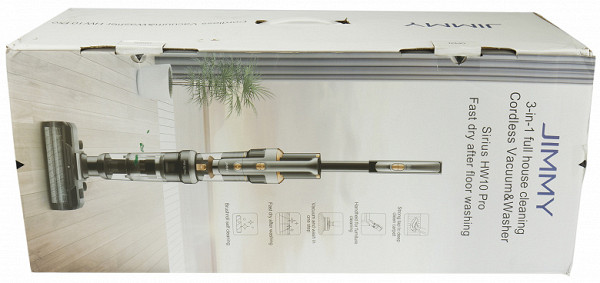
Having opened the box, inside we found:
- motor unit of a vacuum cleaner with an installed container for dry waste
- removable battery
- floor cleaning nozzle with clean and dirty water tanks
- extension tube
- dry floor brush
- motorized furniture brush
- two 2-in-1 brush attachments for manual cleaning
- disassembled charging and cleaning base
- two stands for accessories installed on the base
- bottle of branded floor cleaner
- a brush for cleaning the “dirty” tank
- DC adapter
- user guide
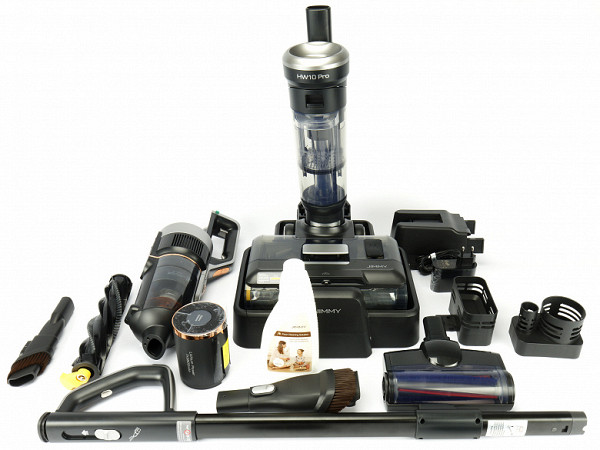
At first sight
The body of the vacuum cleaner is made of dark gray and silver plastic with decorative inserts imitating “red gold”. For some, these decorations may seem like a sign of luxury, but in our opinion, the “golden” inserts slightly disrupt the strict and elegant appearance of the device. However, this is a matter of taste.
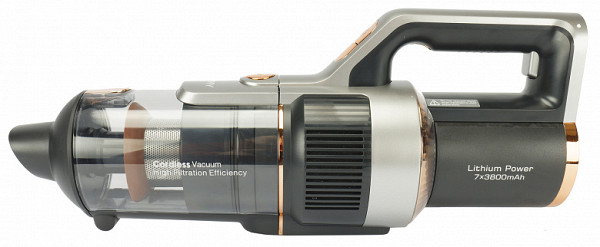
The Jimmy HW10 device has a longitudinal design of the motor block: a cylindrical cyclone filter is located in the same axis with the air path. Behind the garbage disposal is a motor with exhaust grilles, and at the rear of the unit is a removable battery.
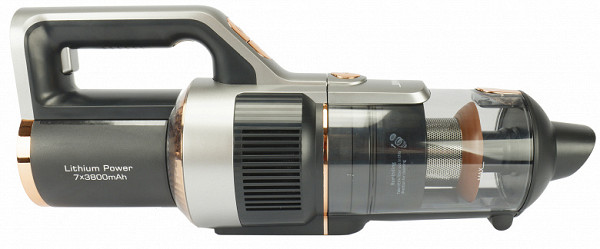
The air blown out of the motor unit leaves it through the grilles on the right and left: thanks to this solution, the flow does not scatter uncollected dust from the working area and does not bother the user.

At the top of the device body there is a D-shaped handle with two control buttons. The third button adjusts the latch holding the dustbin, and the fourth, located closer to the front end, opens the dust container: you can shake it out without removing it from the body and without getting your hands dirty.
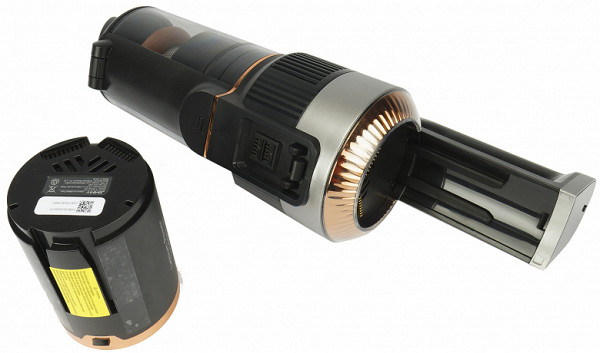
The removable cylindrical battery consists of seven standard 18650 batteries. The manufacturer notes that if individual elements fail, they can be replaced without replacing the entire unit. Thanks to this good maintainability, the device will last longer.
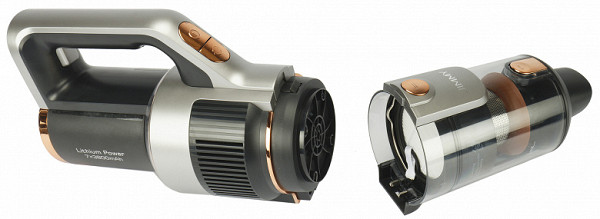
The air flow containing dust and dry debris is directed into the cyclone filter and begins to swirl around the central element. Heavy particles, separated from the flow by a plastic “skirt,” settle at the bottom of the container, while small debris particles are retained by a finely perforated steel grid.
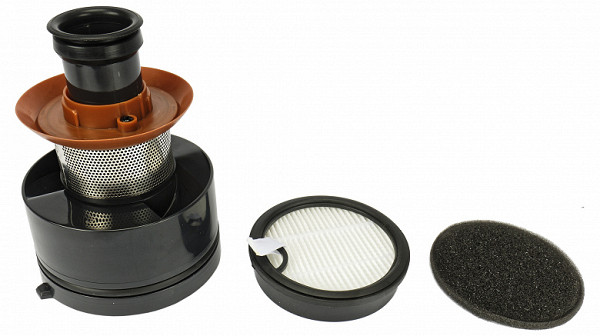
Dust that passes through the grille remains on the HEPA filter, which is protected by a black foam disk.
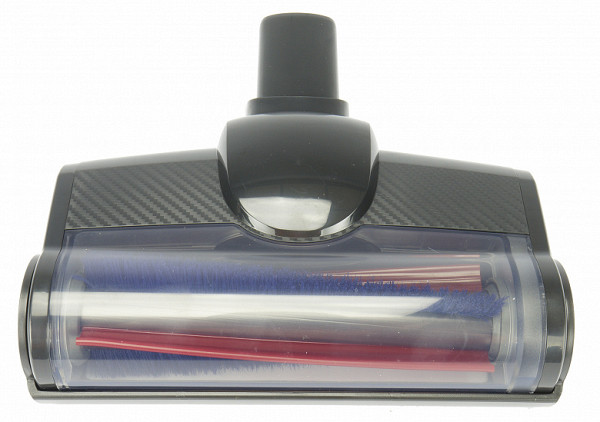
For cleaning in handheld vacuum cleaner mode, the Jimmy HW10 kit includes three attachments: a motor brush for upholstered furniture and two simple ones.
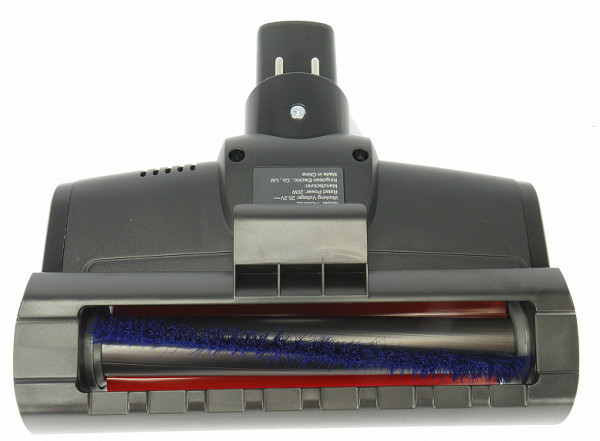
The motor brush has a simple and traditional design. The built-in motor rotates a rotor with three rows of bristles located at a slight angle to the axis. Between them there are three silicone lamellas. The brush has no hinge and is rigidly attached to the motor block.
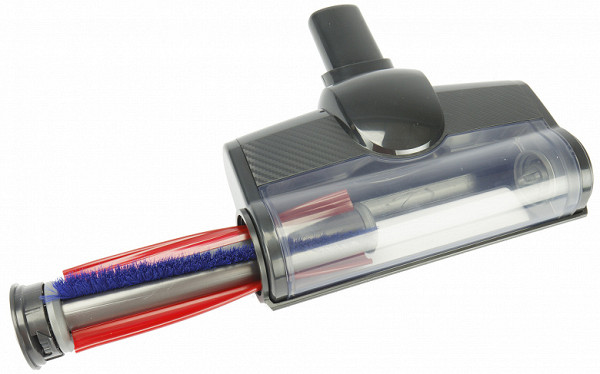
For cleaning and maintenance, the rotor can be removed by turning the round plug on the right end of the nozzle.

For manual cleaning, there are also two 2-in-1 attachments with sliding brushes: wide and narrow. We did not find any innovations in their design — these are standard accessories that are included in many models from various manufacturers.

The extension tube has a dual purpose: in addition to cleaning the floor, it also allows you to reach hard-to-reach places if you attach a brush attachment to one of its ends. This allows you to effectively clean debris from curtain rods and cabinets.
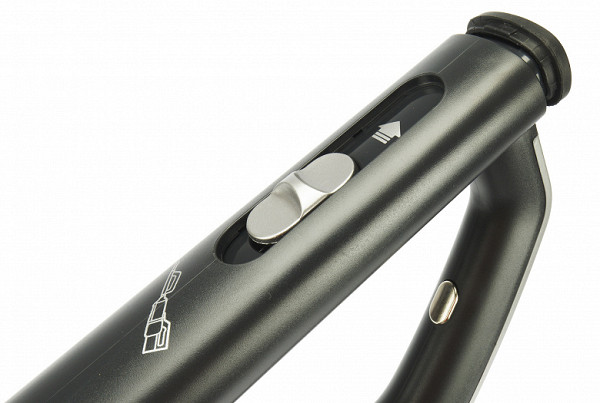
For use in this configuration, a retractable tube is provided that is inserted into the motor block. The explanatory drawing next to it clearly illustrates the correct installation of the accessory.
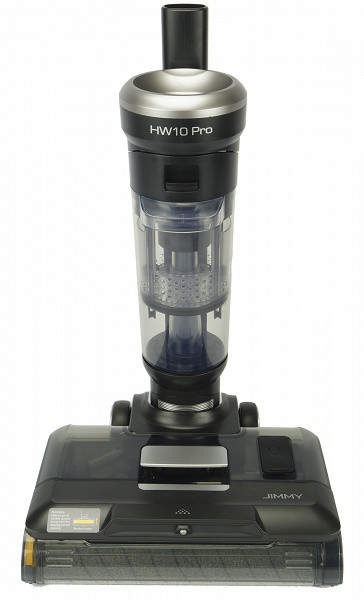
For wet and dry cleaning of floors, the extension tube is inserted into the body of the corresponding device.
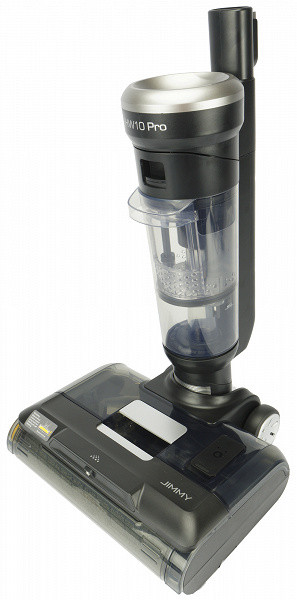
It consists of a vertical body on which a tank for dirty water is mounted, and a motor brush.
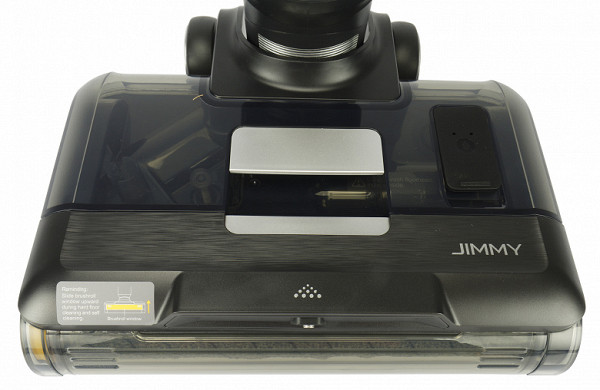
It consists of a vertical body on which a tank for dirty water is mounted, and a motor brush.

The flat tank is made of transparent gray plastic. On the top panel you can see a hole for filling water, which is closed with a rubber stopper. At the bottom there is a spring-loaded valve that controls the flow of water to the brush.
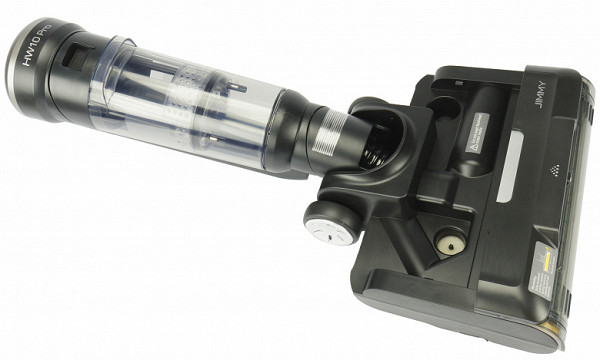
For cleaning the floor, a soft velor roller is provided, which is installed in the front part of the nozzle. The device also includes a rotor for dry cleaning with stiff bristles and double slats arranged in a spiral.
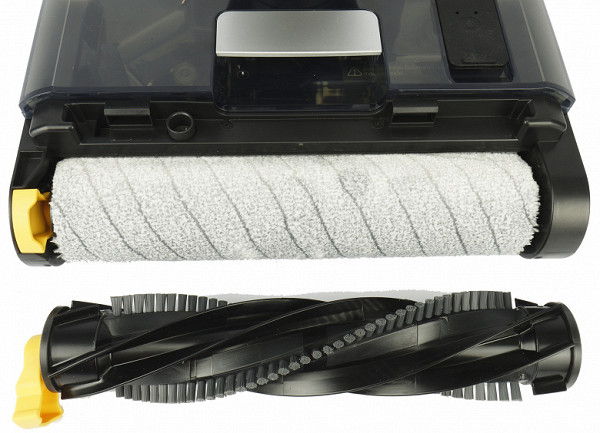
The rotor is closed with a transparent cover, allowing you to easily control its rotation.
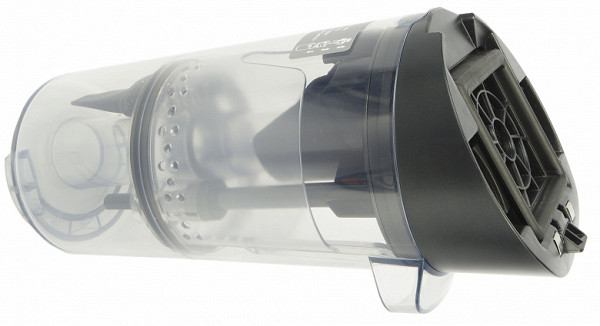
The flow of water and dirt washed off the brush rises through a transparent tube into a tank made of transparent plastic.
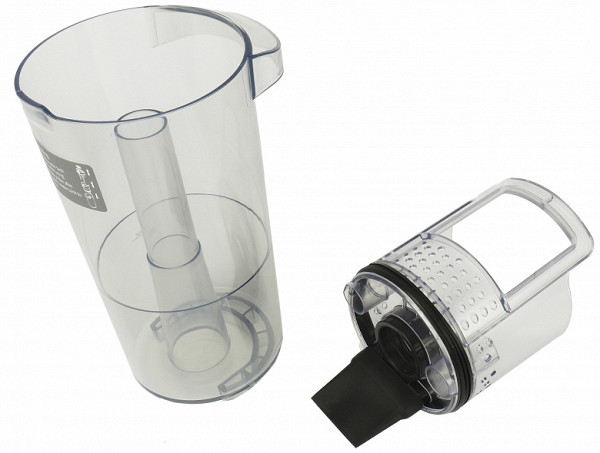
In the upper part of the container there is a perforated separator, on which large fragments of debris remain. The bottom collects dirty liquid, which can be poured down the drain.
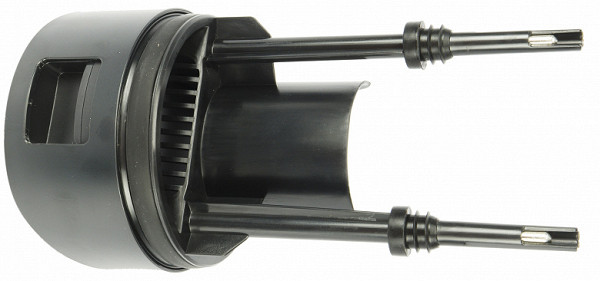
The tank cover is equipped with two contacts that enable the overflow sensor to operate.
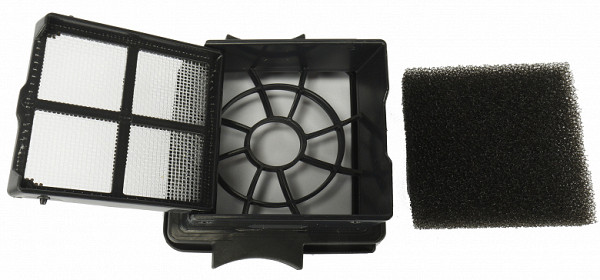
The air flow leaving the container passes through a filter consisting of a fine nylon mesh on a folding frame and a square protective element made of black foam rubber.

The motor unit is installed on the nozzle body from above and secured with a latch.

A base station made of black plastic is designed for servicing and charging the device. At the front of the flat tray there is a recess in which the floor brush rotor is washed during the self-cleaning process. A fan is installed inside the case to dry the brush. Air is supplied to it for several hours after washing, which eliminates the appearance of unpleasant odors and prevents the proliferation of harmful microflora on the velor element.
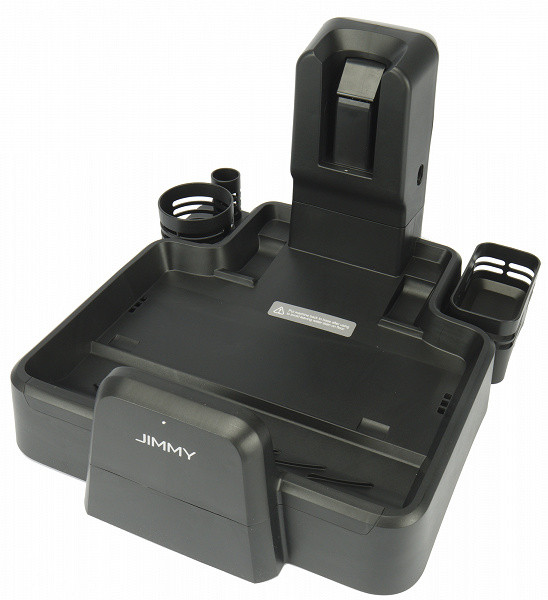
Removable stands for accessories are attached to the right and left of the base station. One of them is designed for a replaceable rotor and brush for cleaning the nozzle, and the second can accommodate a charger or a bottle of detergent.

The vacuum cleaner comes with a thin cylindrical brush that makes cleaning the dirty water tank easier. The diameter of the brush corresponds to the size of the inner shaft of the container.
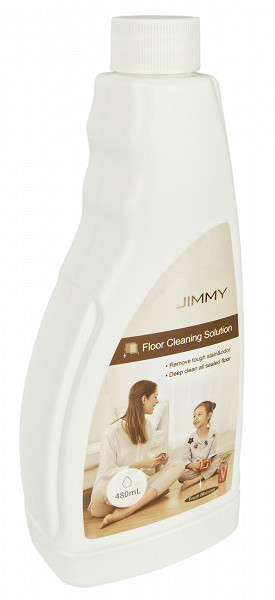
The device comes with a 0.48 liter bottle of branded floor cleaner
Instructions
The user manual is a thick (104 pages) brochure compiled in eight European languages, including Russian. It is printed on thick white paper and the printing quality is excellent.
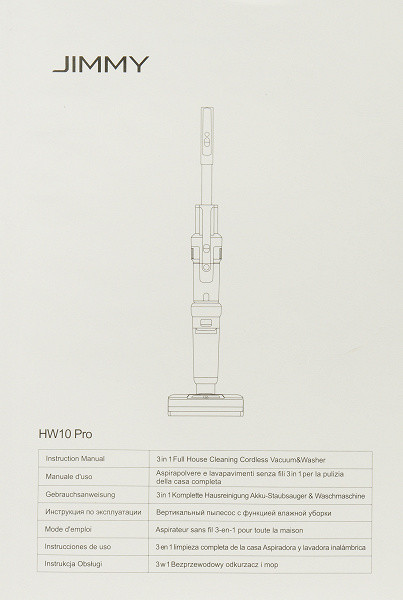
The Russian-language part of the manual takes 16 pages, including many illustrations. It describes in detail the design, assembly and preparation for operation of the Jimmy HW10 Pro vacuum cleaner, as well as instructions for operating the device and its operation. The document also contains valuable tips on caring for the vacuum cleaner, as well as a list of possible malfunctions with methods for eliminating them yourself.
The brochure also includes a schematic diagram of the device, which is rare for modern home appliances.
Control
The vacuum cleaner is controlled by two buttons on the handle of the motor unit. The first turns it on and off, the second serves to switch power.
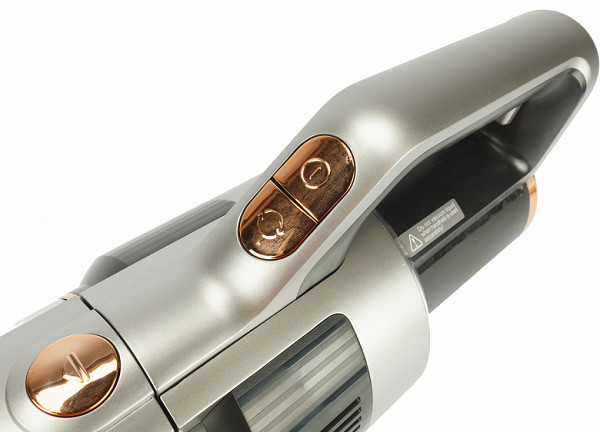
When operating in manual mode, the Jimmy HW10 Pro vacuum cleaner has two power levels available: standard and maximum. And in the floor cleaning mode there are four: automatic, where the power is selected depending on the degree of soiling of the floor, the “Floor” mode for smooth surfaces, the “Carpet” mode for carpets and the maximum “Max” mode.
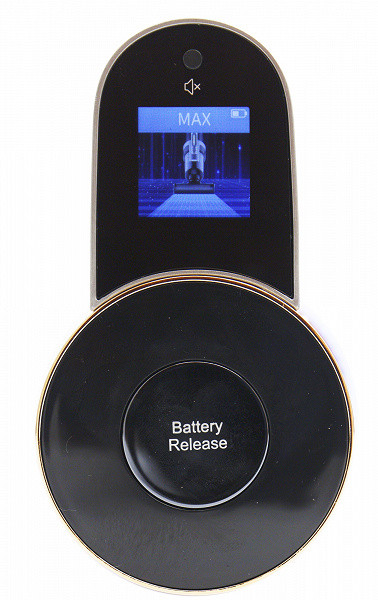
On the flat part of the handle of the motor unit, facing the user, there is a small color LCD screen. During operation, it displays information about the selected power level: an animated icon and the name of the mode.
In the upper right corner of the screen, if you look closely, you will notice a tiny (no more than 30 pixels) battery charge level indicator. Its information content is limited: the three-position scale on the battery image roughly reflects the low, medium and maximum charge levels, but the visualization (white color on a light blue background) is difficult to see even with good eyesight. It would be more convenient to use traditional LED indicators to display battery status.
There is a small button above the screen that turns on and off the voice prompts that accompany the floor cleaning process.
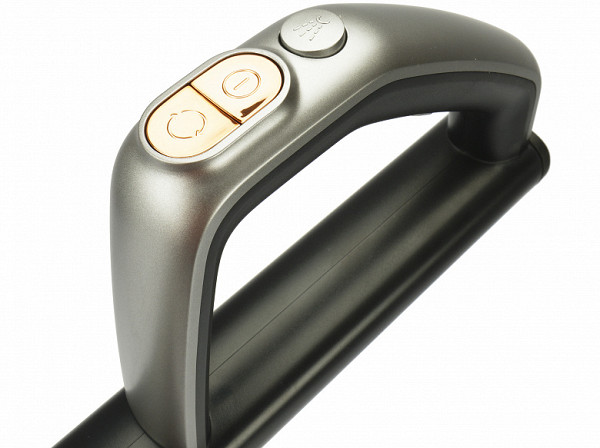
Two buttons on the extension handle duplicate similar elements of the motor unit. The third controls the water supply during wet cleaning.
Exploitation
Before using the vacuum cleaner, you must unpack and assemble it. This process is intuitive and straightforward. Regardless, the instruction manual goes into detail about each step and emphasizes the importance of making sure you click correctly when attaching the latches.
The base station should also be assembled from two parts: vertical and horizontal. To install the accessory holders, attach them to the sides. The included power adapter plugs into the back of the base. When choosing a location for the station, you need to consider access to an electrical outlet.
It is recommended to fully charge the device before turning it on. A full charge cycle takes about three hours, but the first charge may take longer than usual, as with any battery-powered device. To do this, we simply plugged in the device overnight so that by morning it was ready to use for cleaning.

In manual mode, the vacuum cleaner did not give us any surprises: it fits comfortably in the hand, is easy to operate and effectively removes dust from clothes and furniture.

The package includes a motorized brush that makes it easy to remove dust and pet hair from upholstered furniture. However, the lack of a hinge in the connection between the brush and the air path can cause some disappointment, as it reduces the mobility of the structure.
The main function of the Jimmy HW10 vacuum cleaner is, of course, related to sweeping and washing floor coverings.

In floor cleaning mode, Jimmy HW10 can be used for both dry and wet cleaning. Despite the slightly heavier weight compared to conventional upright vacuum cleaners without a wash function, this does not create discomfort during use. The device is well balanced, and the main weight is distributed on soft wheels at the base of the floor nozzle.
The nozzle also has a special parking position that allows you to temporarily stop cleaning. In this case, the vacuum cleaner automatically increases power to maximum for a few seconds to clean the air tract, and then automatically turns off. When cleaning resumes, it turns on again in operating mode.
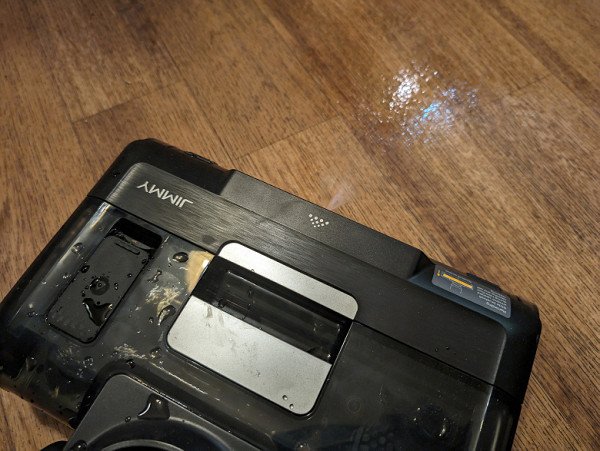
Jimmy HW10 is equipped with a manual water supply system for wet cleaning. To activate the water supply, you must press the button on the handle of the extension tube. A distinctive feature is that the liquid does not flow to the rotating brush, as is usually the case with many washing vacuum cleaners, but directly into the nozzle on the front side of the nozzle.
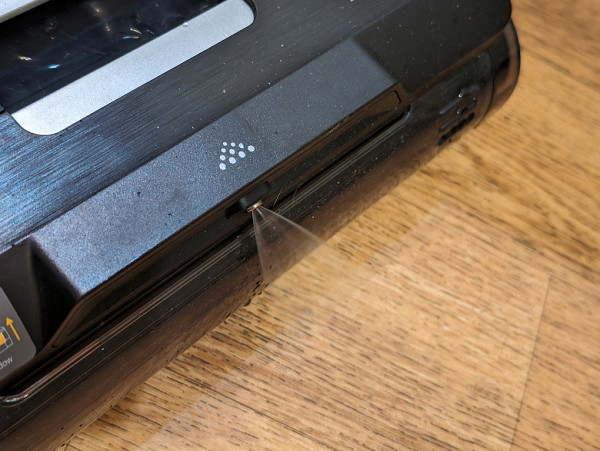
Water is sprayed evenly in a fan, moistening the area in front of the vacuum cleaner. After this, the liquid is collected by a rotating velor brush and, along with dust and debris, is sent to the aquafilter. This system is probably preferable to traditional brush wetting: the user can better see areas that require more intense hydration and have more control over the process.
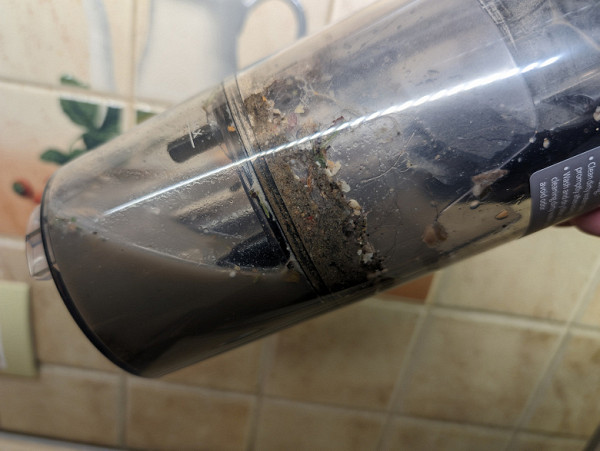
Most of the debris during wet cleaning is retained in the separator basket. Solid contaminants are easily shaken out into the trash can, and accumulated liquid at the bottom can be disposed of by releasing it into the drain.
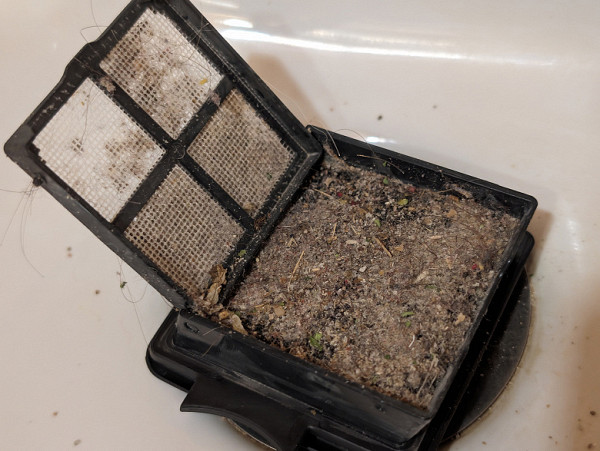
A noticeable part of the debris remains on the washable filter: when cleaning the container, you must not forget this element.
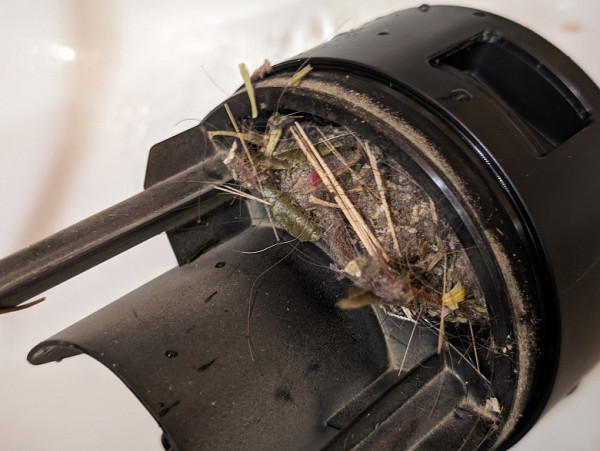
It is not recommended to start cleaning if the water filter is empty or the device is running dry. In this case, debris can easily pass through the main reservoir and accumulate under the lid. Even if you plan to only dry clean, you should leave some liquid in the reservoir.
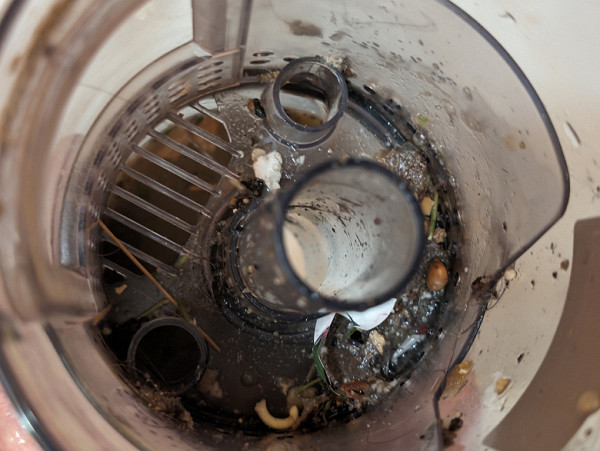
You can easily get rid of wet debris from the tank by simply shaking it into a trash can, which will not harm the sewer system.
The volumes of tanks for clean and dirty liquids are the same for this model. By installing a tank of clean water on a dry device, you don’t have to worry about consumption until the aquafilter is full. When the capacity reaches its limit, a sensor will trigger, indicating the need to remove the dirty liquid. It is also worth filling the bottom container with clean water.
If problems occur with the vacuum cleaner, it informs the user via voice messages and duplicates the information on the screen. Test warnings on the display are accompanied by animated images, but due to the small size and low resolution of the display, they may sometimes not be obvious.
The implementation of the charge level indicator seems to be the least informative, since the tiny battery symbol in the corner of the screen is difficult to notice during operation.
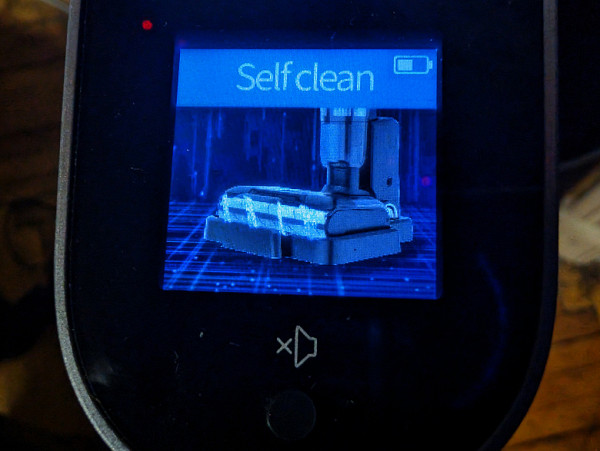
Upon completion of wet cleaning, you need to install the device on the base, empty the dirty water from the tank, fill the lower tank with clean water and start the self-cleaning mode with the button on the handle. In a few minutes, the vacuum cleaner rinses the brush, periodically increasing the power to maximum to clean the air tract. At the end of the process, the device reminds you to pour out the dirty water again and replenish the supply with clean water.
Having completed self-cleaning, the vacuum cleaner turns on the base station fan, which dries the brush for several hours. Automatic drying prevents the development of bacteria on the surface of the rotor, causing an unpleasant odor.
Care
After each cleaning, you should clean the dirty water tank, as the vacuum cleaner itself reminds you to do.
The dry waste bin should be emptied when it is full. Thanks to the hinged lid, you can do this without the risk of getting your hands dirty.
The roller brush must be regularly inspected for threads, hair and pet fur wound around the rotor, and, if necessary, removed.
The manufacturer reminds you that during long breaks in use, you must empty the clean water tank and both waste containers and thoroughly clean the device.
Our measurements
We present the mass measurements of the main components of the vacuum cleaner in the table:
| Weight, g | |
|---|---|
| Motor block | 970 |
| Battery | 640 |
| Extension tube | 380 |
| Floor nozzle with electric brush | 2685 |
| 2-in-1 brush attachment | 45 |
| 2-in-1 crevice nozzle | 40 |
The volume of the clean water tank is 370 milliliters. The weight of a fully equipped vacuum cleaner in the wet cleaning configuration is 5045 g, and in the minimum manual cleaning configuration it is 1650 g.
We measured the suction power when operating the vacuum cleaner without a pipe and nozzles in two modes. The graph of the dependence of suction power on the created vacuum is shown below:
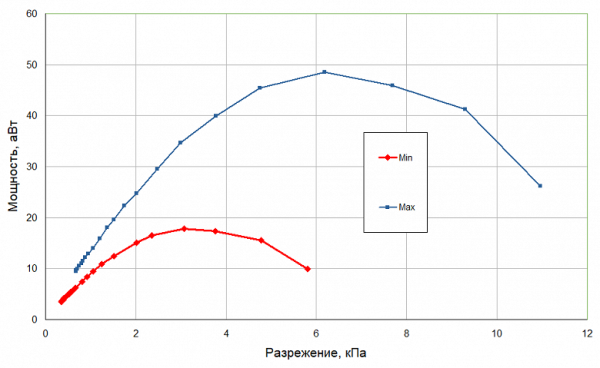
The measured suction power was 48.5 aW in maximum mode and 17.8 aW in minimum mode.
When the stand valve is completely closed, overheating protection is triggered and the device turns off, which is displayed on both graphs.
The noise level when operating in manual mode ranges from 72 to 78 dBA for the minimum and maximum power levels, respectively. In the floor cleaning configuration, the sound pressure, depending on the mode, ranges from 82 to 85 dBA.
Battery life depends on the accessories used and the selected mode. In the manual configuration, the vacuum cleaner has two power levels. At minimum, the model runs up to 76 minutes.
When the charge level reaches a critical limit when operating at maximum power, the device reduces the speed to minimum, allowing you to complete cleaning. After 29 minutes of intensive work, the vacuum cleaner runs for another 12 minutes at minimum power, providing 41 minutes of autonomy.
In wet cleaning mode, battery life is 33 minutes at Floor level, 24 minutes at Carpet level (plus 2 minutes at minimum power) and 22 minutes at Turbo level (plus 2 minutes at minimum power).
A completely discharged device charges on average in 3 hours 10 minutes. The charger consumes up to 38.4 W, and a full cycle requires about 0.105 kWh.
Let's summarize our measurements in one table:
| Maximum suction power | 48.5 aW |
|---|---|
| Duration of operation at maximum power | 22 minutes |
| Duration of operation in manual mode | 76 minutes |
| Noise level | up to 85 dBA |
| Weight in wet floor configuration | 5045 g |
| Weight in manual configuration | 1650 g |
conclusions
Jimmy HW10 Pro combines one hand-held vacuum cleaner and two vertical ones — for dry and wet floor cleaning. It is easily transformed and equally convenient in all three forms.

The 3-in-1 concept is not yet widespread in the world of vacuum cleaners. Until now, we have only seen one device of this type, released by Redmond. However, we are confident that such devices will become increasingly popular on the market, since their design seems quite viable to us. Using one device instead of two or three promises to be convenient for many users.
The Jimmy HW10 Pro handles sweeping and mopping tasks, is easy to maintain, and has good battery life in each of its three configurations. Among the disadvantages of the device, it is worth noting the rather high noise level, the not very informative liquid crystal display and the significant weight of the device, especially in the configuration for wet cleaning.
Pros:
- universal model for dry cleaning, floor washing and tidying up manually
- original and efficient water supply system
- convenient control
- automatic power control in wet cleaning mode
Minuses:
- high noise level at maximum power
- heavy weight of the floor nozzle

